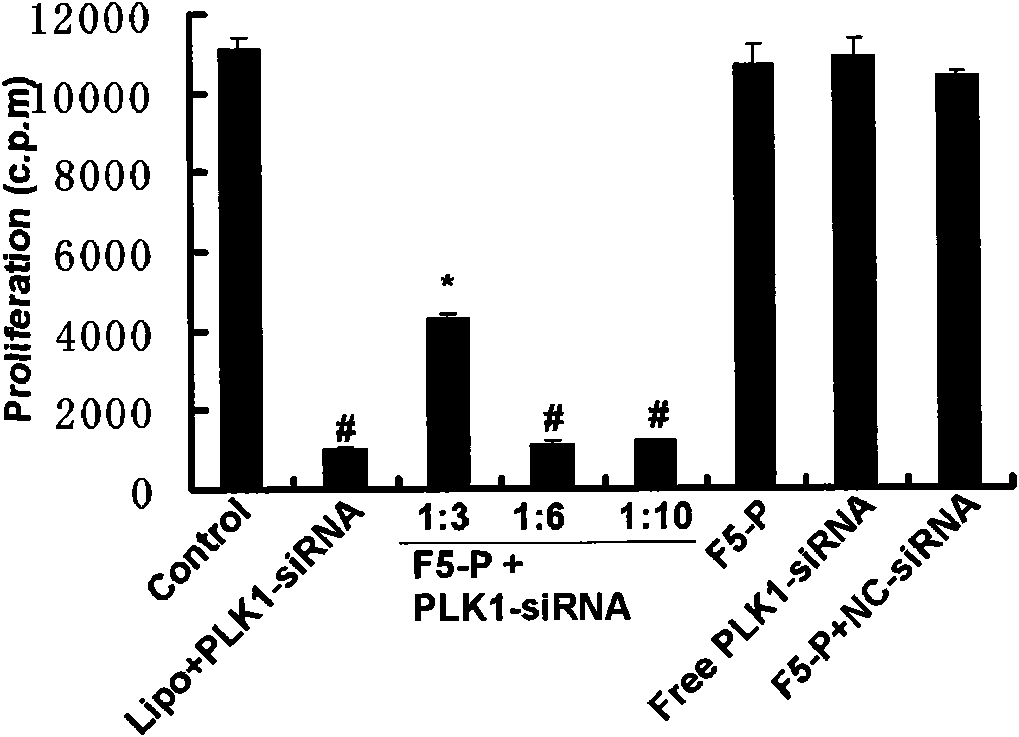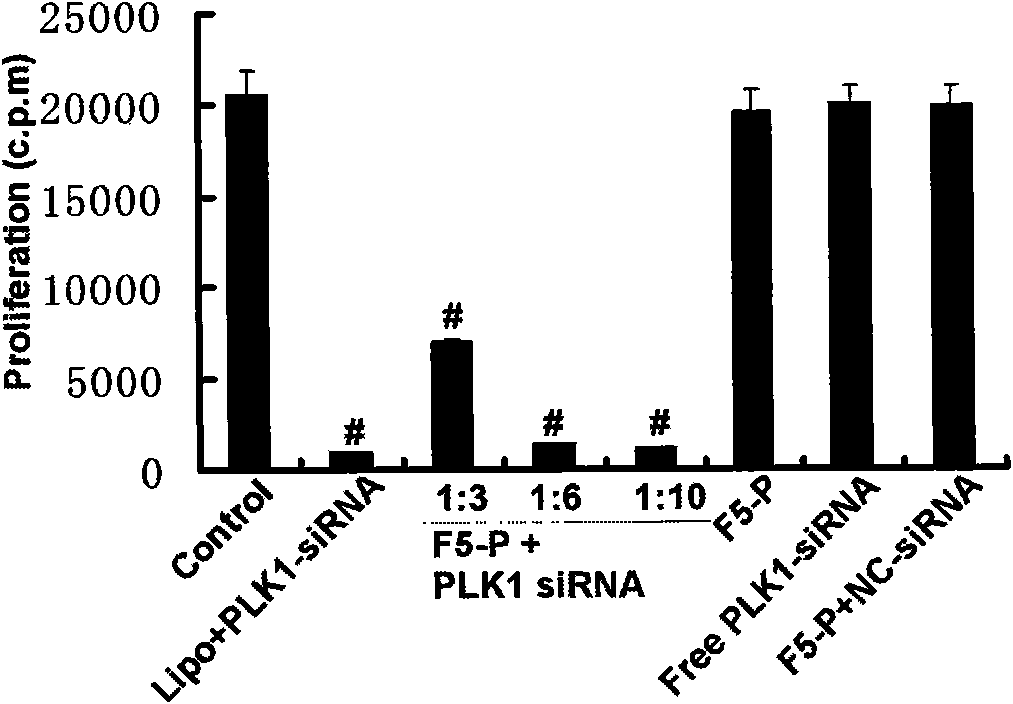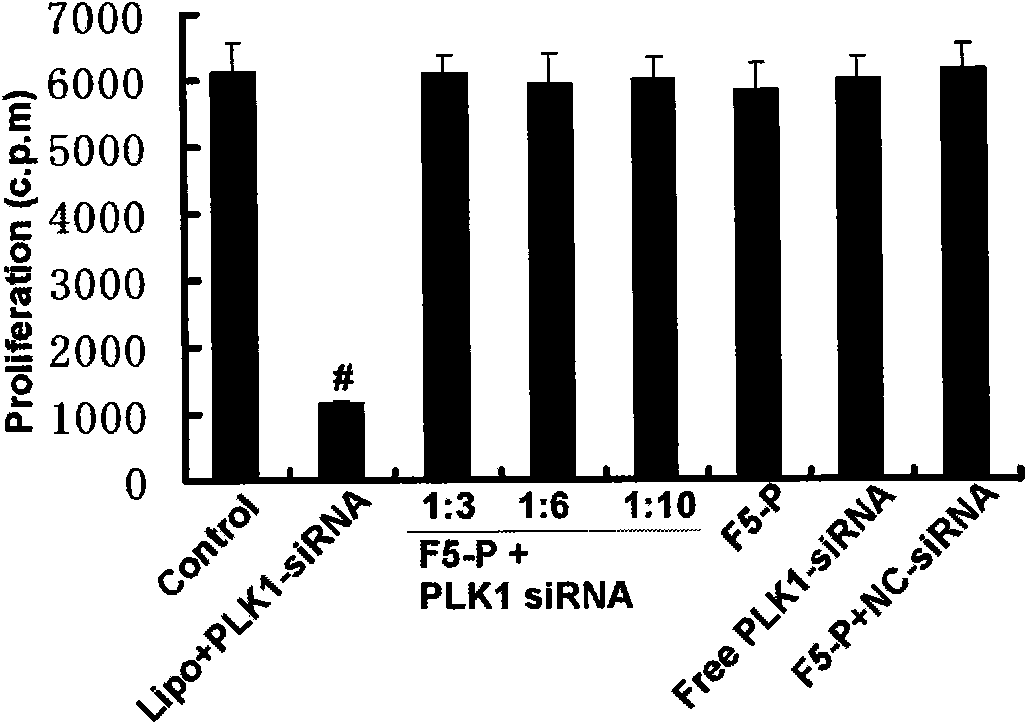Method for inhibiting proliferation and inducing apoptosis of cancer cells and use thereof
A cancer cell, apoptosis technology, applied in inhibiting the proliferation of cancer cells and inducing their apoptosis and its application fields, can solve the problems of not being suitable for biological missiles, not biological missiles, affecting the therapeutic effect, etc., to reduce the impact, reduce side effects, Improves the effect of gene silencing effects
- Summary
- Abstract
- Description
- Claims
- Application Information
AI Technical Summary
Problems solved by technology
Method used
Image
Examples
Embodiment 1
[0042] Example 1: Cell recovery and subculture
[0043] Cell recovery is performed as follows:
[0044] 1. Take out the cryopreservation tubes of breast cancer SKBR3, BT 474 and MDA-MB 231 cells from liquid nitrogen or cryogenic refrigerators and put them directly into warm water at 37°C. Keep the top of the cryovials above the water surface to avoid any contamination and shake gently Let its contents melt as soon as possible.
[0045] 2. Take out the cryopreservation tube from the water bath at 37°C, centrifuge at 800rpm×2min, disinfect it with alcohol and open it, suck out the supernatant with a dropper, inject 1ml of basic culture medium and mix well, then transfer it to a graduated centrifuge tube to make a cell suspension Centrifuge at 800 rpm for 2 min at low speed, remove the supernatant, and wash with culture medium again if necessary.
[0046] 3. After appropriate dilution with RPMI 1640, L15 and DMEM / F12 culture medium containing 10% FBS, transfer the inoculated ce...
Embodiment 2
[0053] Example 2: Transfection of cell seed plate for MTT experiment
[0054] The steps of MTT experiment for cell plate transfection are as follows:
[0055] 1. Human breast cancer cells SKBR3, BT 474 and MDA-MB 231 covered 95% of the bottom of the bottle and then digested with 0.25% trypsin;
[0056] 2. Count the cell suspension by blowing it evenly, and calculate the number of cells per milliliter of the suspension;
[0057] 3. Plant the cells in a 96-well plate, the number of cells per well is about 7000 MDA-MB 231 cells and 10000 BT-474 and SKBR3 cells;
[0058] 4. Carry out transfection experiment after 24 hours;
[0059] 5. Replace with RPMI 1640, L15 and DMEM / F12 fresh medium containing 10% FBS (fetal bovine serum);
[0060] 6. Set each processing factor and add corresponding reagents;
[0061] Control (optimized medium), liposomal Lipofectamine 2000+PLK1siRNA, F5-P1+PLK1siRNA, F5-P2+PLK1siRNA, F5-P3+PLK1siRNA, F5-P3, PLKsiRNA and F5-P3+NC-siRNA
[0062] Wherein, ...
Embodiment 3
[0074] Example 3: Cell seed plate transfection 3 H thymidine incorporation assay
[0075] The operation steps are as follows:
[0076] 1. Human breast cancer cells SKBR3, BT 474 and MDA-MB 231 covered 95% of the bottom of the bottle and then digested with 0.25% trypsin;
[0077] 2. Count the cell suspension by blowing it evenly, and calculate the number of cells per milliliter of the suspension;
[0078] 3. Seed the cells in a 96-well plate, the number of cells per well is about 7000 MDA-MB 231 cells and 10000 BT-474 and SKBR3 cells;
[0079] 4. Carry out transfection experiment after 24 hours;
[0080] 5. Replace with fresh medium;
[0081] 6. Set each processing factor and add corresponding reagents;
[0082] Control (optimized medium), Lipofectamine2000+PLK1siRNA, F5-P1+PLK1siRNA, F5-P2+PLK1siRNA, F5-P3+PLK1siRNA, F5-P3, PLK1siRNA and F5-P3+NC-siRNA
[0083] 7. After adding the corresponding reagents to each group, the mixture was incubated on ice for 30 minutes;
[...
PUM
 Login to View More
Login to View More Abstract
Description
Claims
Application Information
 Login to View More
Login to View More - R&D
- Intellectual Property
- Life Sciences
- Materials
- Tech Scout
- Unparalleled Data Quality
- Higher Quality Content
- 60% Fewer Hallucinations
Browse by: Latest US Patents, China's latest patents, Technical Efficacy Thesaurus, Application Domain, Technology Topic, Popular Technical Reports.
© 2025 PatSnap. All rights reserved.Legal|Privacy policy|Modern Slavery Act Transparency Statement|Sitemap|About US| Contact US: help@patsnap.com



